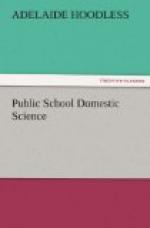COAL.
Coal (anthracite) is about 95 per cent. carbon. It kindles slowly, gives a steady heat, and burns for a longer time without attention than wood. Stoves for burning oil and gas have become popular, and are very convenient and satisfactory for cooking purposes.
OIL.
Oil is considered to be the cheapest fuel.
GAS.
Gas is a very satisfactory fuel for cooking purposes, but can only be used in certain localities.
Making and Care of a Fire.
CARE OF A FIRE.
Great care should be exercised in the selection of a stove or range. The plainer the range the easier it will be to keep it clean. There should be plenty of dampers that can be used to hasten the fire or to check it. Learn thoroughly the management of the range before beginning to cook. In lighting a fire, remove the covers, brush the soot from the top of the oven into the fire-box; clean out the grate (saving all the unburned coal, and cinders). Put in shavings or paper, then kindling arranged crosswise, allowing plenty of air space between the pieces, a little hard wood and a single layer of coal. Put on the covers, open the direct draft and oven damper, then light the paper. When the wood is thoroughly kindled and the first layer of coal heated, fill the fire-box with coal even with the top of the oven. When the blue flame becomes white, close the oven damper, and when the coal is burning freely, shut the direct draft. When coal becomes bright red all through it has lost most of its heat. A great deal of coal is wasted by filling the fire-box too full and leaving the drafts open till the coal is red. To keep a steady fire it is better to add a little coal often rather than to add a large quantity and allow it to burn out. Never allow dust or cinders to accumulate around a range, either inside or out. Learn to open and shut the oven door quietly and quickly. Study the amount of fire required to heat the oven to the desired temperature. Learn which is the hotter or cooler side of the oven, and move the article which is being baked as required, being very careful to move it gently.
Measurements.
Accurate measurement is necessary to insure success in cooking. As there is such a diversity of opinion as to what constitutes a heaping spoonful, all the measurements given in this book will be by level spoonfuls. A cupful is all the cup will hold without running over, and the cup is one holding 1/2 pint.
The following table may be used where scales are not convenient:—
4 cups of flour = 1 pound or 1 quart. 2 cups of solid butter = 1 " 1/2 cup butter = 1/4 " 2 cups granulated sugar = 1 " 2-1/2 cups powdered sugar = 1 " 3 cups meal = 1 " 1 pint of milk or water = 1 " 1 pint chopped meat, packed




